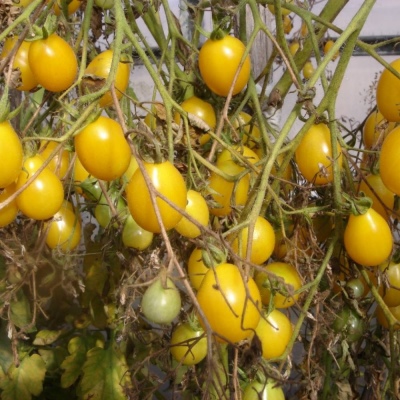
- Authors: Gavrish S.F., Morev V.V., Degovtsova T.V., Vasilyeva M.Yu., Artemyeva G.M., Redichkina T.A., Aleksashin S.A.
- Year of approval: 2017
- Category: grade
- Growth type: indeterminate
- Appointment: fresh consumption
- Ripening period: early
- Ripening time, days: 90-95
- Growing conditions: for open ground, for film greenhouses
- Bush size: tall
- Leaves: long, green
Ildi is a tall variety of tomatoes, most often grown in greenhouse conditions and in open soil with a garter to the supports. The variety will allow you to get a large full harvest.
Description of the variety
Ildi tomatoes have long leaf blades of rich green color. The inflorescence of vegetation is complex. Most often, the fruits are used fresh, for the preparation of various salads, but they can also be preserved.
The main qualities of the fruit
Ripe fruits have a bright yellow-green color, their shape is oval cream. The pulp of ripe vegetables is quite dense. One cluster contains about 100 fruits. The mass of each such small vegetable is 15-30 grams.
Taste characteristics
Ripe tomatoes of this variety boast excellent taste. They can be added to various dishes.
Ripening and fruiting
The Ildi variety belongs to the early ones. Ripening dates are approximately 90-95 days after planting in the ground. This variety bears fruit quite abundantly, but at the same time all fruits are small in size.
Yield
This tomato variety is characterized by a relatively high yield level. It will allow you to get up to 200 fruits from one bush.
The timing of planting seedlings and planting in the ground
Sowing should be carried out approximately 50-55 days before transfer to the greenhouse. For the middle lane, mid-March will be the best option; in the southern regions, this can be done at the very beginning of spring.

Growing tomato seedlings is an extremely important process, because it largely depends on whether the gardener will be able to harvest at all. All aspects must be taken into account, from seedbed preparation to planting in the ground.
Landing scheme
When planting in the ground, the distance between the bushes should be at least 50 centimeters. The distance between the individual rows should be approximately 60 centimeters.

Growing and care
The seeds of this culture are considered small enough, therefore, it will be necessary to work with them as carefully as possible so as not to lose them. It is not necessary to deepen the seed material during planting, you can simply sprinkle it slightly with soil.
Seedling soil can be purchased ready-made in a garden store or made by yourself. In the second case, it is necessary to mix earth and peat with each other into a homogeneous mass, and one pinch of ash is also added.
Before planting in the ground, it is better to additionally process the seeds in a solution of potassium permanganate. After the seeds are planted, they are covered with plastic wrap. The containers should be stored in a dry place at a temperature of about 25 degrees Celsius.
After the appearance of the first leaves, the vegetation dives. For planting the material, you can pick up plastic cups or special pots for seedlings.
About 2-3 weeks before transplanting to a permanent place, the plants are hardened at a temperature of 15-17 degrees. When the stems begin to take on a purple color, the seedlings can already be transferred to the open ground.
Remember that immediately after planting, you need to thoroughly mulch the soil; for this, peat, spruce branches and straw are most often used. After a few weeks, it is worth pinching.
The bushes will also need to be tied to a trellis or other supporting structure. We must not forget about feeding. They must be paid every two weeks. Usually peat, humus and ash are used for this. It is best to alternate them with ready-made complex mineral fertilizers.




A plant needs different micronutrients at each stage of growth. All fertilizers can be divided into two groups: mineral and organic. Folk remedies are often used: iodine, yeast, bird droppings, eggshells.
It is important to observe the rate and period of feeding. This also applies to folk remedies and organic fertilizers.
Disease and pest resistance
The Ildi variety is highly resistant to various diseases and pests. But still, sometimes it can be affected by fungal infections. To avoid their appearance, it is necessary to carry out timely preventive treatments. To do this, you can use Bordeaux liquid.
Also, for the prevention and control of harmful fungi, various effective fungicides can be suitable. Among gardeners, the preparations "Skor", "Maxim", "Kumir" are very popular.
If tomato bushes were affected by aphids, then it is better to use simple folk compositions prepared at home. In this case, tinctures with onion peels, chopped garlic heads can be excellent. Sometimes solutions with mustard powder and baking soda are used. For greater efficiency, a little crushed laundry soap is also added to the finished formulations.
To combat various harmful insects, special insecticides are often used - Tornado, Green Soap, Biotlin. Regularly, you need to carefully inspect all vegetation for the presence of harmful organisms and signs of disease in order to start treatment in a timely manner and save the culture.



























































































